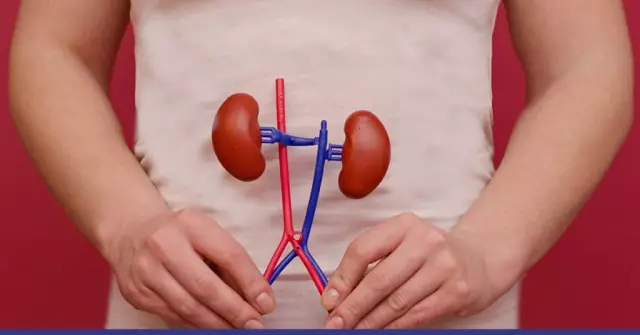- Author Rachel Wainwright [email protected].
- Public 2023-12-15 07:39.
- Last modified 2025-11-02 20:14.
Tonsillectomy: what is it, methods, recovery, complications
The content of the article:
- Indications for tonsillectomy
- Contraindications to tonsillectomy
- Preparing for surgery
- Pain relief methods
- Methods for removing tonsils
- Features of the postoperative period
- How much sore throat after surgery on the palatine tonsils?
- Complications after surgery
- Video
Tonsillectomy is performed for recurrent sore throat, complicated course of the disease or ineffectiveness of conservative treatment of chronic tonsillitis.

Tonsillectomy - surgery to remove tonsils
Tonsillectomy - what is it? This is an operation aimed at completely removing the tonsils along with the adjacent capsule. This method remains one of the most common surgical procedures.
Bilateral tonsillectomy is most commonly performed.
Indications for tonsillectomy
The indications for the removal of the tonsils are:
- chronic tonsillitis of a simple or toxic-allergic form of I degree in the absence of the effect of conservative treatment;
- chronic tonsillitis toxic-allergic II degree;
- chronic tonsillitis, complicated by paratonsillitis;
- a history of paratonsillar abscesses;
- suspicion of tuberculous lesion of the tonsil;
- tumor transformation of lymphoid tissue;
- tonsillogenic sepsis.
Contraindications to tonsillectomy
Removal of tonsils is contraindicated in the following diseases:
- severe diabetes mellitus, in the presence of ketone bodies in the urine;
- chronic kidney disease with severe renal failure;
- the presence of a heart defect with severe heart failure II - III degree;
- diseases of the hematopoietic system, accompanied by hemorrhagic diathesis, including hemophilia;
- active form of pulmonary tuberculosis;
- cirrhosis of the liver.
Acute inflammatory diseases, such as acute tonsillitis, acute pharyngitis, acute inflammation of the nasal mucosa and paranasal sinuses, as well as the presence of carious teeth, menstruation, and the last weeks of pregnancy, are temporary contraindications to surgery.
Preparing for surgery
Preparation before surgery includes:
- examination by a therapist;
- chest x-ray or fluorography;
- clinical blood test;
- general urine analysis;
- blood for HIV infection, syphilis, hepatitis B and C;
- coagulogram;
- blood chemistry;
- ECG (electrocardiography);
- teeth sanitation;
- a smear from the mucous membrane of the tonsils and the posterior pharyngeal wall for bacteriological culture and, in particular, for the presence of a diphtheria bacillus (Leffler's bacillus).

Before the operation, a clinical blood test and a coagulogram are prescribed
If necessary, an examination of narrow specialists is carried out: a rheumatologist, endocrinologist, immunologist and others.
Special training is required in the presence of somatic diseases.
With hypertension, antihypertensive drugs are prescribed.
Patients with diabetes are advised to increase their carbohydrate intake and the amount of insulin administered. This will increase the oxidative processes in the body and prevent hyperglycemia due to operational stress.
In the presence of rheumatological diseases, as well as in nephritis, the operation is performed against the background of anti-relapse therapy with penicillin antibiotics.
For the prevention of bleeding, calcium preparations, Vikasol and ascorbic acid are prescribed. In this case, the patient should start taking medication 3-5 days before the operation.
On the eve of the surgical intervention, sedatives are prescribed, and 30 minutes before the start, premedication is carried out, aimed at reducing the patient's anxiety level, reducing the secretion of glands and enhancing the action of drugs for anesthesia. Premedication is performed using an analgesic, atropine, and an antihistamine.
Pain relief methods
In most cases, removal of the palatine tonsils in adults is performed under local anesthesia in a sitting position, but if necessary, under general anesthesia.
Local anesthesia involves several stages. To begin with, the mucous membrane of the oropharynx is treated with a spray of 10% Lidocaine. Then infiltration anesthesia is performed with 2% Lidocaine solution. The anesthetic is injected with a thin long needle to a depth of about 1 cm at several points: in the upper, middle and lower sections of the amygdala, as well as in the region of the posterior arch.
Methods for removing tonsils
The main method of removing the tonsils is tonsillectomy with a scalpel and scissors.
The traditional operation is as follows: a scalpel is used to cut the mucous membrane in the upper part of the anterior palatine arch; the anterior palatine arch is separated all over; the posterior arch together with the capsule are separated to the lower pole; the lower pole is cut off with a loop.

Traditionally, surgery is performed using a scalpel and tonsillectoma
During the operation, it is important to take into account the distance from the palatine tonsil to the vascular bundle of the neck, which is located in the parapharyngeal space and includes the internal and external carotid arteries.
After removal of the tonsils, hemostasis is performed with a dry swab, electrocoagulation or hemostatic paste.
Modern methods of surgical treatment of chronic tonsillitis include radio wave, ultrasound, cold plasma, laser tonsillectomy and cryodestruction.
During cryodestruction, liquid nitrogen is applied, after which the affected tissue detaches.
With the radio wave method, the tissues are cauterized with subsequent coagulation of the vessels. Rehabilitation can be long, since not only the lymphoid tissue of the tonsils is exposed to heating, but also the underlying layers and the surrounding mucous membranes.
Laser removal involves the destruction of lymphoid tissue by evaporating fluid from cells. High-energy laser radiation coagulates blood vessels, forming blood clots. When using a holmium laser, vascular coagulation occurs due to vascular twisting.
One of the promising methods is ultrasonic exposure. At the same time, low-frequency ultrasound acts on the lymphoid tissue, heating the tissue and contributing to their destruction.

One of the possible surgical methods is cold plasma tonsillectomy
A coblation or cold plasma tonsillectomy is performed with an apparatus that converts electricity into a plasma stream.
Unlike laser removal, the action of plasma does not cause burns of the mucous membrane of the pharynx and underlying tissues, and unlike cryodestruction, their necrosis does not occur. The device allows you to control the depth and area of impact.
According to reviews, coblator tonsillectomy is a very effective method with a less painful recovery period after surgery. Photos and videos of this procedure confirm minimal bleeding during removal with a coblator, since the device coagulates the vessels.
Tonsillectomy and tonsillotomy, what's the difference? In some situations, removal of only part of the palatine tonsil is required, for example, with hypertrophy of lymphoid tissue, which interferes with oral or nasal breathing. In this case, tonsillotomy is performed. Often the enlargement of the tonsils is combined with the presence of adenoid vegetations, which are also subject to adenotomy.
Features of the postoperative period
An individual approach plays an important role in the postoperative period. Much will depend on the concomitant pathology, the characteristics of the operation and the postoperative course, the complications that have arisen.

Nutrition plays an important role in the rehabilitation period
After surgery, bed rest is recommended for several days.
On the first day after removal, it is not allowed to eat, drink or talk.
In the next week, it is recommended to adhere to a certain diet, drink enough liquid, follow the doctor's prescription.
Nutrition in the postoperative period should be as gentle as possible, with the exception of hard, rough, spicy foods. Mashed potatoes, cereals, custard-like desserts, popsicles, and cold drinks are allowed, which may help reduce tissue swelling. It is recommended to drink at least 8 glasses of liquid daily, such as water, juice, soda.
For 10 days after the operation, heavy physical exertion and sports should be avoided. You can't cough, clear your throat, blow your nose. Therefore, it is necessary to exclude visiting the pool, since during swimming, water enters the nose and can provoke an increase in pressure and swelling of the mucous membranes of the nose, paranasal sinuses and oropharynx.
During sleep, it is recommended to keep your head slightly raised and lie down mainly on the right side.
How much sore throat after surgery on the palatine tonsils?
Pain after surgery significantly reduces the quality of life of patients.
According to modern concepts, pain is considered as a complex psycho-emotional unpleasant sensation, in the implementation of which the nociceptive system plays an important role, providing perception, transmission and analysis of the pain signal.
Pain plays a protective role by promoting a pain-relieving response.
Postoperative pain is caused by inflammation and is associated with irritation of the nerve endings by pro-inflammatory mediators. At the same time, the processes of vasodilation and sweating of plasma proteins are activated, highly active substances are released - serotonin, histamine, bradykinin, substance P, prostaglandins, thromboxanes, leukotrienes. It is these biologically active substances that are involved in the occurrence of pain, edema and an increase in body temperature.
The duration of the pain period on average varies from 2 to 8 days. If at the end of this period the throat hurts again, you need to see a doctor. In cases where the tonsils are not completely removed, the remains of lymphoid tissue can hypertrophy and cause sore throat again. But in some cases, the lower pole of the palatine tonsils is intentionally left due to the peculiarities of the blood supply, difficulties in tissue extraction due to scars, or in order to preserve physiological function.

If the symptoms of tonsillitis return, the risk of infection increases.
Pain in the pharynx worsens when swallowing saliva, eating, talking, turning and tilting the head. Because of this, the patient can restrict his movements, which contributes to a longer persistence of inflammation and increases the risk of infection in the postoperative area and slowing down the healing process.
After the operation, the doctor actively prescribes local drugs with anesthetic and anti-inflammatory effect (Strepsils).
Cleansing the tonsillar niche from the formed fibrin occurs 5-10 days after the operation. By this time, the discomfort in the throat at rest and when swallowing passes.
According to indications, antibiotics are prescribed in the postoperative period. Preference is given to drugs with a wide spectrum of action. The duration of admission is on average 5 days.
Complications after surgery
One of the most frequent and dangerous complications is bleeding, which can occur during surgery, in the early or late postoperative period.

In order to control the development of complications in the postoperative period, pharyngoscopy is performed
During surgery, a suture is placed on the bleeding vessel.
In case of bleeding in the postoperative period, a thorough pharyngoscopy is performed to identify the source of bleeding and suture the vessel. But most often, the introduction of a tampon with a hemostatic agent is sufficient.
Usually, hemostatic therapy is prescribed, which affects the blood coagulation system:
- Dicinone (intramuscularly);
- Tranexam (intravenous);
- 10% solution of calcium chloride or gluconate;
- 5% aminocaproic acid solution intravenously.
When bleeding occurs, monitor blood pressure, hemoglobin levels, and possible blood aspiration. If blood aspiration occurs during or after surgery, then bronchoscopy is performed using an electric suction.
In the postoperative period, inflammation increases and edema of the soft palate and larynx may occur. For the prevention and treatment of such a condition, anti-edema therapy is prescribed, and intubation is performed if signs of respiratory failure increase.
In rare cases, pulmonary edema may be a complication of surgical removal of the tonsils. Edema prevention measures include an elevated upper body position, oxygen therapy, sedation, corticosteroids, and, if indicated, intubation and mechanical ventilation (mechanical ventilation).
If, after removing the tonsils, the patient becomes ill with ARVI (acute respiratory viral disease) or influenza, you should immediately consult a doctor to avoid inflammatory complications.
In order to timely prevent various consequences of the operation and shorten the rehabilitation period, it is necessary to adhere to the prescriptions of the attending physician.
Video
We offer for viewing a video on the topic of the article.

Alina Ervasova Obstetrician-gynecologist, consultant About the author
Education: First Moscow State Medical University. THEM. Sechenov.
Work experience: 4 years of work in private practice.
Found a mistake in the text? Select it and press Ctrl + Enter.






